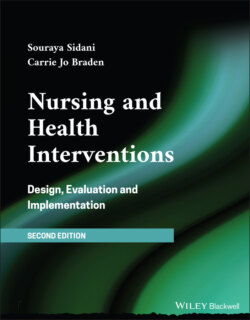Читать книгу Nursing and Health Interventions - Souraya Sidani - Страница 75
Methods
ОглавлениеThe process for planning and conducting primary studies is well described in basic and advanced research textbooks, and is not reviewed here. However, some key considerations are briefly mentioned.
The main focus of the study is on the health problem and its determinants, as experienced by the target client population in the context of interest.
The study is designed to address the specific gap in knowledge about the problem as experienced by the target client population and the context of interest. Quantitative, cross‐sectional or longitudinal studies aim to: (1) describe the experience of the problem (e.g. frequency of occurrence, severity, most common indicators) and its determinants and consequences at one point in time, or changes in the problem experience and determinants over time; (2) examine factors that operate at different levels and contribute most significantly to the problem as experienced by the target client population and the context of interest; or (3) test the theory of the problem derived from relevant middle range theories or empirical evidence. Qualitative studies can be designed to: (1) generate inductively the conceptualization of the health problem held by the target client population, or (2) elicit clients' perceptions of the determinants and consequences, as well explanations of the inter‐relationships among determinants, problem, and consequences. The gaps in knowledge to address dictate the general research approach to utilize.
The specific research design and methods (e.g. online survey, face‐to‐face unstructured interviews) are selected for their consistency and appropriateness in addressing the study aims. The choice of methods should take into account the size of the accessible client population and anticipated response rate (e.g. low response rates have been reported for some populations like immigrant older adults); logistics of client recruitment in the context of interest (e.g. it may be hard to reach community‐dwelling substance users); the preference or comfort of the client population with specific research methods (e.g. ability to access a computer, and skills enabling completion of online surveys); availability of validated instruments that measure the problem, determinants and consequences; and ability to access human and material resources required to conduct the study within a reasonable time frame.
The data collection procedures are carefully planned and executed in order to minimize the potential for response burden and introduction of biases (such as acquiescence, social desirability) that threaten the validity of findings.
The data analysis is done rigorously, using appropriate analytic techniques that allow the determination of factors that most significantly contribute to the problem experience, the delineation of the inter‐relationships (direct and indirect) among the determinants and the problem, and the elucidation of the clients' explanations of these inter‐relationships.
